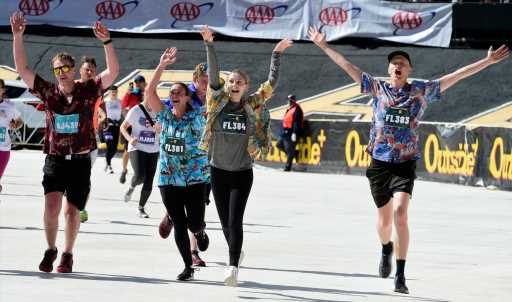
America’s running event industry faces a “watershed moment” that threatens its future because of the habits and attitudes held by Gen Z and young millennials, according to conclusions drawn from a survey commissioned by Running USA, an industry trade association.
In conjunction with USA Track & Field and World Athletics, which is the global governing body for track and field, Running USA released a report on Monday titled, “Gen Z and Young Millennial Attitudes Toward Running,” based on a survey conducted in 2022. The results were announced at the annual Running USA Industry Conference, which is being held in Denver.
“Now that Gen Z is coming of age and millennials are aging, participating in running is threatening to trend downward,” the report states. “The desire for exercise and motivations for being physically and mentally fit are changing drastically.”
The survey queried 2,500 young people, equally split between Gen Z (ages 18-24) and young millennials (25-30). It found that two-thirds of the respondents prefer walking for physical fitness, and that Gen Z participates in fitness sports less than any other age group.
“The primary fitness goal of the generation is not around health but friends, fun and purpose,” the report says. “They are not as competitive as those preceding them.”
The results could be alarming for race organizers because older runners are aging out of the sport while fewer younger runners are taking it up. The percentage of runners in the 35-44 and 45-54 age groups has dropped significantly since 2015, while the percentage of race participants in the 25-34 age group grew only slightly.
“If the running industry ignores this trend,” the report says, “it is at risk of its future growth.”
The first “running boom” of the 1970s, and a second that ran from the late 1990s through the early 2000s, were driven largely by competitive recreational runners. Young people today, if they run at all, are looking for something different from running events, race organizers say. They are seeking social interaction and races with unique themes or causes.
“If we have an aging running demographic, and we’re not backfilling it, and we’re not making running look cool, or running and jogging as an outlet for fitness, I think we as a sport have our work cut out for us,” said Cliff Bosley, race director of the Bolder Boulder. “And if it’s not going to be about the competitive part of the sport but it’s going to be the social, how do we make our events as fun as possible, really connecting with that social thing?”
Despite the concerns over 20-something interest and involvement, the Bolder Boulder may be bucking the trend. Bosley said the percentage of 20-something Bolder Boulder runners as a segment of the overall field has steadily increased in each of the past six races from 14.24% in 2015 to 19.68 in 2022. The race was not held in 2020 and 2021 because of the pandemic.
That may be because the Bolder Boulder offers race-day experiences beyond simply running, including the Memorial Day observance at Folsom Field. The Running USA study says offering ancillary experiences is key in attracting young runners, and Colfax Marathon race director Andrea Dowdy says that’s a key element of her marketing strategy.
“It isn’t just about putting one foot in front of the other,” Dowdy said. “It’s about creating a goal and creating a day that has meaning to folks, whether they are 18-30 or above 30. We do get the demographic that includes Gen Z and millennials. If a race is not paying attention to the fact that it needs to offer a race experience that’s for people of this younger demographic, they will be in trouble.”
Lonnie Somers, a Denver race organizer who puts on dozens of running events across the country, said races have to be personable, engaging and unique to attract young people. His five-event RunDenver Series consistently attracts 900 to 1,100 participants per race. He says race organizers must keep their events fresh to attract and retain young runners.
“They’re doing it more for the social camaraderie aspect of things,” Somers said. “If you bore them, they’re not going to come back. If your event is the exact same every year without offering anything different, they don’t come back. They may do it once, and they’re not coming back.”
Subscribe to our weekly newsletter, The Adventurist, to get outdoors news sent straight to your inbox.
Source: Read Full Article









